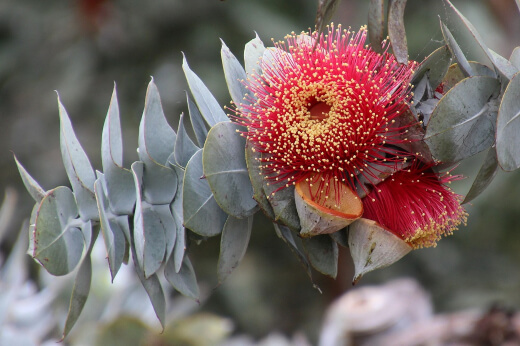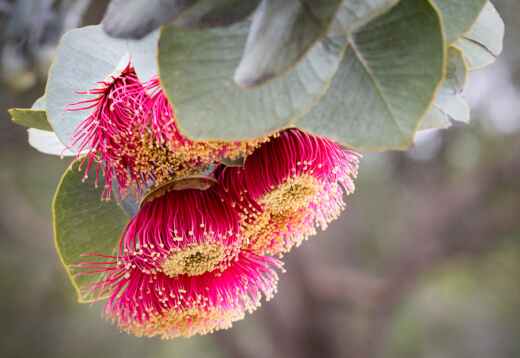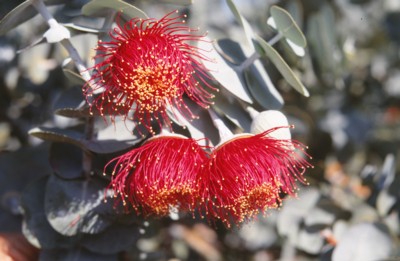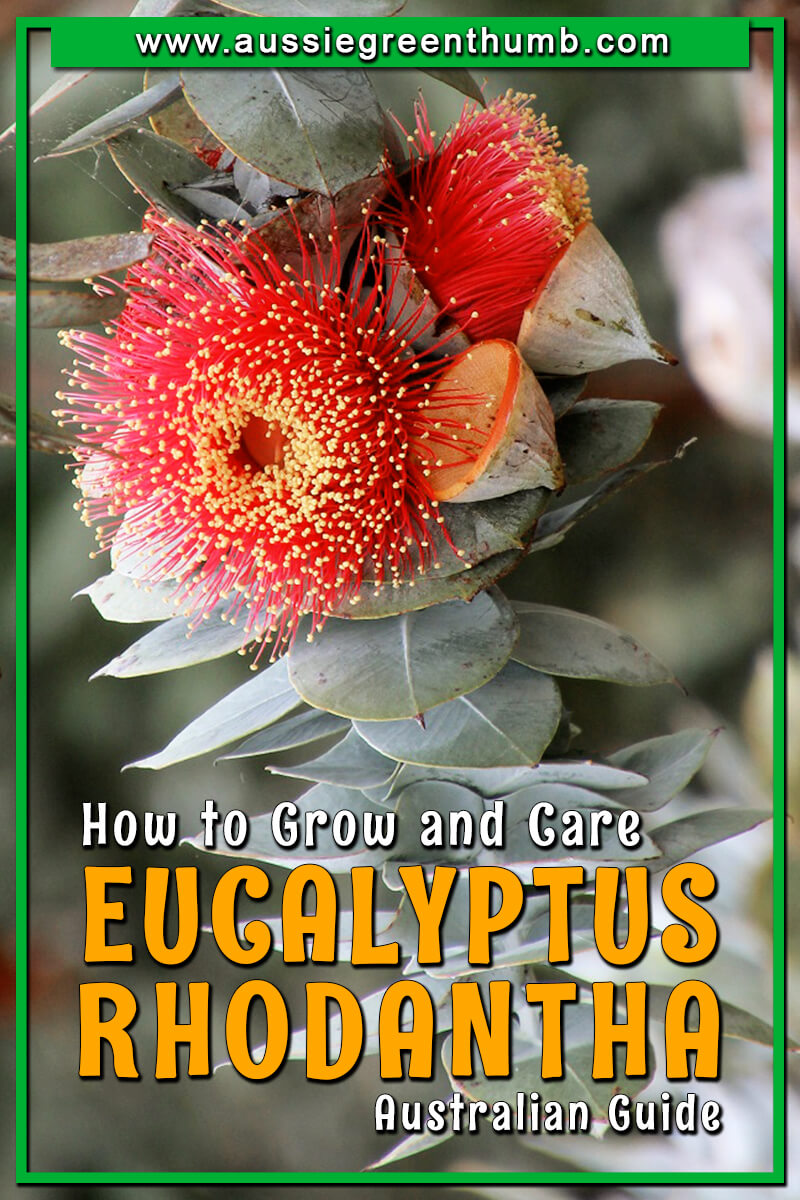Eucalyptus plants are well-known, Aussie natives and many provide an excellent ornamental plant for low-maintenance gardens. The Eucalyptus rhodantha, more commonly known as the Rose mallee, is a fantastic offering from the eucalyptus with blooms that look like they’ve come straight out of a sci-fi movie.
This low-spreading flora is quickly grown and requires very little maintenance once established, making it an ideal option for beginner growers. Here is our growing and care guide for the Eucalyptus rhodantha.
More...
Rose Mallee Eucalyptus rhodantha Features
Many eucalyptus plants are better known as mallee trees, and the Rhodantha, rose mallee or rose gum has afforded its name from it’s gorgeous red and pink blooms.
This evergreen perennial forms part of the Myrtaceae family and the sub-family myrtoidae. This specific cultivar is usually found along the Wheatbelt of Western Australia; however, it has now become very rare to see in nature.
Family: Myrtaceae
Genus: Eucalyptus
Species: E. rhodantha
Common Name: Rose mallee
Flower Colour: Red
Foliage Colour: Silver
Growth Habit: Shrub 3m+
Flowering: Autumn to Winter

Source: Austraflora.com
The Eucalyptus rhodantha is considered a threatened species, as outlined by the Commonwealth’s Endangered Species Protection Act of 1992. Still, it seems to have risen in popularity in residential areas.
This wonderfully exciting eucalyptus is considered to be a smaller, spreading tree with intriguing, horizontally growing, bluish-grey branches and bright red blooms.
How to Grow Eucalyptus rhodantha
Eucalyptus rhodantha is, in fact, one of the easiest grown Australian natives and propagation from seed is mostly successful. It is used to warmer climates, so it enjoys plenty of sun and well-draining soil.
With the right conditions, Eucalyptus rhodantha can grow as tall as 4 metres high. However, it is considered more of a spreader than a tall grower.
Can You Grow Eucalyptus in Pots
Some cultivars are large-growing, however, the rhodantha is perfectly suited for container growing. You will need to ensure your container is in a sunny spot and that your potting mix is extremely well-draining.
How to Propagate Eucalyptus rhodantha from Seed

Source: Austraflora.com
Seeds propagation is best suited for this type of eucalyptus and should be done in spring or autumn. The rose mallee struggles to germinate when it is either extremely hot or cold. Optimum germination temperature is between 18° to 22°C.
We recommend purchasing your seeds from a licensed supplier for optimal results.


Get Your Free Guide:
Master Growing Australian Natives eBook
A Must Have Complete Guide for Every Australian Garden
Get Your Free Guide:
Master Growing Australian Natives eBook
A Must Have Complete Guide for Every Australian Garden
To sow, simply:
- Place your seed on the top of a porous seeding mix. Sprinkle with a fine layer of seeding mix, taking care not to cover the seed fully.
- Give it a good water, allowing the seed to lodge itself.
- Keep the soil semi-moist by regular misting, taking care not to dislodge the seed.
Germination will take anywhere between 10 to 28 days. Some seeds may take longer, so don’t be too hasty to throw seeds away if you do not see results.
Can You Root Eucalyptus Cuttings in Water
While this is not an ideal method, it is possible to root your cutting in water. You will need to make a cutting of 8-12 centimetres, just underneath the node. Then, remove all lower leaves from the cutting.
After that, you can leave the cutting in a water glass for a few days to begin rooting. After a week, plant into a porous potting mix.
How to Plant Eucalyptus rhodantha
It is not recommended to plant your Rhodantha outside if it is a cold season. Young plants will need to be protected from the cold.
Once the weather is warmer, you can either move your pots outside or plant your Rhodantha directly into your garden.
You’ll need to:
- Dig a hole at least twice the size of your previous container.
- Backfill until your desired depth. This loose soil will help your Rhodantha roots grow with ease.
- Place your plant in the hole and fill.
- Mulch around the base stem to suppress any weeds.
It is recommended to feed your young plants with some extra phosphorous to encourage vigorous root growth.
How to Care for Your Eucalyptus rhodantha

While growing Eucalyptus rhodantha might take a little effort, after that it will require very little maintenance other than some semi-occasional pruning and watering.
Watering Rose Mallee
This cultivar is remarkably drought-tolerant, and over-watering will quickly lead to problems like root rot. It will need very little water, and if kept outside, natural rainfall will give it all the water it may need.
Pruning Eucalyptus rhodantha
This is a spreader plant, so pruning will only be needed to maintain shape and size. Tip-pruning is recommended.
Pest & Disease Problems
The Eucalyptus rhodantha is quite sensitive to herbicides and pesticides sprays. Hence, it’s important only to make use of natural repellents should you notice any unwanted insects or an overgrowth of weeds.
Eucalyptus beetles, or long-horned borers, can become a problem if not treated. You’ll notice a beetle infestation by large oval-shaped holes in your leaves.
The most common problem of the rose mallee is a root-rot fungus, primarily caused by over-watering. Depending on the rot’s severity, you can either cut-back on watering or will need to re-plant your rose mallee and discard the affected soil.
Rose Mallee Uses and Landscaping Applications
The Rhodantha really does make a great feature plant for any garden, especially for those who want a low-maintenance plant.
While it is mostly grown in residential areas for its attractive foliage, it has also been known to be used as a screening plant or windbreaker. Plus, it’s root-systems can help with soil erosion.
This cultivar is also particularly slope-tolerant due to its fibrous root system, making it quite adaptable in various garden types. More so, the rose mallee is a well-known nesting plant for native birds and provides nectar-rich pollen, which will support local honey production.
Not only will you have an eye-catching addition to your garden, but you’ll be able to enjoy plenty of little visitors, including birds, bees and even some rabbits.
You will want to note that the rose mallee, along with many other trees, has a strong fragrance emitted from the leaves. Some people enjoy the smell. However, some may find it an issue.
Eucalyptus Rhodantha Frequently Asked Questions
When does Eucalyptus rhodantha flower?
E. rhodantha, or the rose Mallee, flowers from July, right through to January in most of Australia, and sometimes as early as March. Its vivid red flowers are unmistakable, with their fused petals and sepals forming a cup, from which the anthers protrude.
What is the best place to plant Eucalyptus rhodantha?
The best place to plant E. rhodantha is in full sun, on sandy, free-draining soil. In clay soils or damp gardens, plant E. rhodantha in raised beds, or dig copious amounts of grit into the base of planting holes to aid drainage.
Are Eucalyptus rhodantha drought tolerant?
E. rhodantha is one of the most drought tolerant native trees in Australia. Its natural habitat is dry, fairly arid open land, where it grows in thickets and natural groves.
Young plants need extra protection from damp conditions too, as they are very susceptible to root rot for the first couple of years.
Is Eucalyptus rhodantha invasive?
E. rhodantha is not an invasive species but will self-seed in the garden if given a chance. The saplings are easy to pull up, and their roots are easy to remove, so it’s a good plant for low-medium maintenance gardens.
How deep are Eucalyptus rhodantha roots?
E. rhodantha is shallow rooted, rarely reaching below 40-50cm deep in the soil. Their natural habitat has very little ground water, so wide roots ensure every drop is caught by the plant before it drains below the topsoil.
Why is Eucalyptus rhodantha called the Rose Gum Tree?
E. rhodantha has two common names; the Rose Mallee, or the Rose Gum Tree. Eucalyptus gum is a useful resource for a plethora of medicinal uses, and its flowers are a stunning rosy red.
Two traits that directly lend themselves to this descriptively named plant.
How do you identify Eucalyptus rhodantha?
E. rhodantha is easy to identify, with bright red flowers, and fused petals and sepals, forming a distinct cup beneath its flowers. The sepals form neatly and seamlessly from the branches, and are a near identical colour to the silvery-blue foliage that covers the rest of the tree.
What part of Australia is Eucalyptus rhodantha native to?
E. rhodantha is native to all parts of Western Australia, and can form dense masses of shrubby growth in the wild, where it spreads out in low growing forms, reaching just 4m tall (tiny compared to most mature Eucalyptus species).
Is Eucalyptus rhodantha good for bees?
All Eucalyptus are beneficial to bees, but the closed cups of E. rhodantha can be challenging for pollinators to access. In the absence of open-flowered eucalyptus, E. rhodantha does still provide some nectar for bees and pollinators though.
What are Eucalyptus rhodantha leaves used for?
E. rhodantha, like all Eucalyptus species, has incredibly useful leaves, packed with strong essential oils which help to relieve the symptoms of cold and flu, open airways and promote relaxation.
The cooling effect of Eucalyptus oil extracted from leaves and twigs is also an excellent anti-inflammatory and cooling agent.
What are Eucalyptus rhodantha bark used for?
E. rhodantha bark is useful as a dye material, but also has mild antiseptic properties, and the oil extracted from eucalyptus bark and leaves can be used, mixed with water and saponins (natural soap) to clean your home, body, or cuts and grazes.
Is Eucalyptus rhodantha frost hardy?
E. rhodantha can survive short frosts, and temperatures down to about -10C. However, young plants should be protected from frost for the first two years by wrapping them with garden fleece, or bringing pots indoors, or near the house.
Mature trees shouldn’t need protection in all but the worst winters.
If you're keen on discovering how to cultivate additional stunning Eucalyptus species in your garden, explore our comprehensive guides below for further insights:

Summing Up Our Eucalyptus rhodantha Guide
Wherever you decide to grow your Eucalyptus rhodantha, you’ll be guaranteed plenty of visual splendour throughout most of the year. Throughout it’s growing cycle, keep in mind that it’s a drought-tolerant plant and requires very little water.
To add some excitement to your garden and support this endangered species, start growing your Eucalyptus rhodantha plant today!
Published on January 18, 2023 by Nathan Schwartz
Last Updated on January 25, 2025




